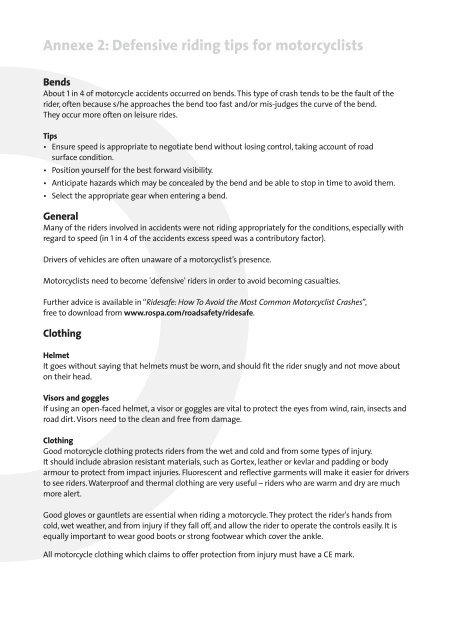Safer Motorcycling Through Work - Network - Motorcycle Action Group
Safer Motorcycling Through Work - Network - Motorcycle Action Group
Safer Motorcycling Through Work - Network - Motorcycle Action Group
You also want an ePaper? Increase the reach of your titles
YUMPU automatically turns print PDFs into web optimized ePapers that Google loves.
Annexe 2: Defensive riding tips for motorcyclists<br />
Bends<br />
About 1 in 4 of motorcycle accidents occurred on bends. This type of crash tends to be the fault of the<br />
rider, often because s/he approaches the bend too fast and/or mis-judges the curve of the bend.<br />
They occur more often on leisure rides.<br />
Tips<br />
• Ensure speed is appropriate to negotiate bend without losing control, taking account of road<br />
surface condition.<br />
• Position yourself for the best forward visibility.<br />
• Anticipate hazards which may be concealed by the bend and be able to stop in time to avoid them.<br />
• Select the appropriate gear when entering a bend.<br />
General<br />
Many of the riders involved in accidents were not riding appropriately for the conditions, especially with<br />
regard to speed (in 1 in 4 of the accidents excess speed was a contributory factor).<br />
Drivers of vehicles are often unaware of a motorcyclist’s presence.<br />
Motorcyclists need to become 'defensive' riders in order to avoid becoming casualties.<br />
Further advice is available in “Ridesafe: How To Avoid the Most Common Motorcyclist Crashes”,<br />
free to download from www.rospa.com/roadsafety/ridesafe.<br />
Clothing<br />
Helmet<br />
It goes without saying that helmets must be worn, and should fit the rider snugly and not move about<br />
on their head.<br />
Visors and goggles<br />
If using an open-faced helmet, a visor or goggles are vital to protect the eyes from wind, rain, insects and<br />
road dirt. Visors need to the clean and free from damage.<br />
Clothing<br />
Good motorcycle clothing protects riders from the wet and cold and from some types of injury.<br />
It should include abrasion resistant materials, such as Gortex, leather or kevlar and padding or body<br />
armour to protect from impact injuries. Fluorescent and reflective garments will make it easier for drivers<br />
to see riders. Waterproof and thermal clothing are very useful – riders who are warm and dry are much<br />
more alert.<br />
Good gloves or gauntlets are essential when riding a motorcycle. They protect the rider's hands from<br />
cold, wet weather, and from injury if they fall off, and allow the rider to operate the controls easily. It is<br />
equally important to wear good boots or strong footwear which cover the ankle.<br />
All motorcycle clothing which claims to offer protection from injury must have a CE mark.


